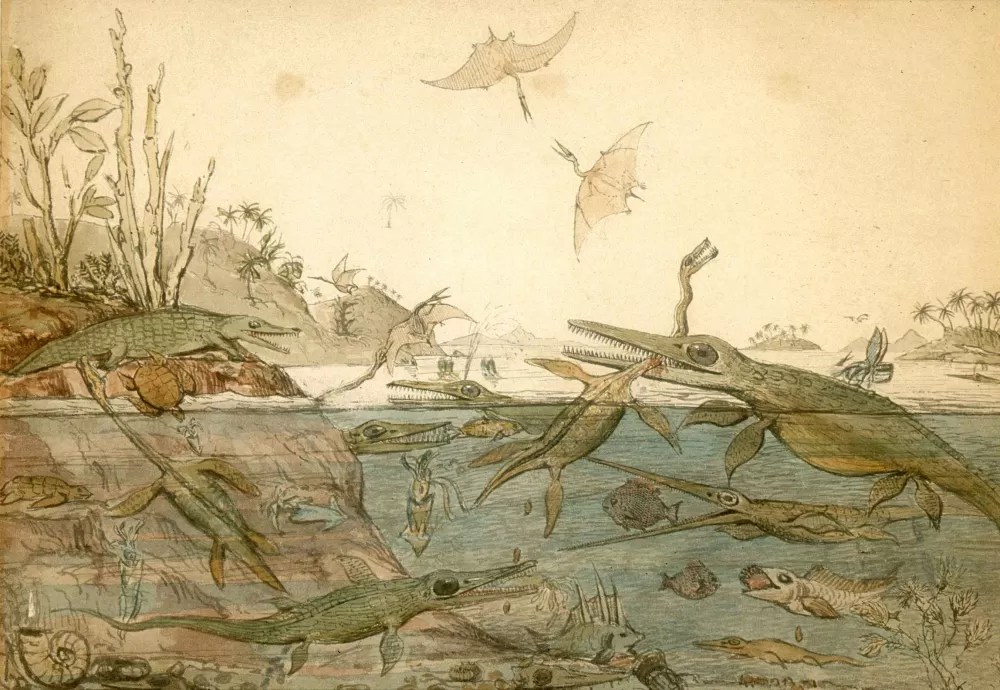Living at the extremes of the Triassic era would’ve been pretty rough. It started and finished with massive extinction events, picking up from the end of the single-continent Permian period around 250 million years ago, and giving way to the Jurassic period 50 million years later. The creatures of the Triassic era were a diverse combination of apocalypse survivors, short-lived wonders, and the earliest forms of dinosaurs called the archosaurs.
One such archosaur was the genus of the Tanystropheus—ancient water-dwelling reptiles with wildly long and skinny necks. First discovered in Germany over 170 years ago, the largest specimens of Tanystropheus had a neck that stretched nearly 10 feet. These strange beasts used their tiny skulls and extensive, inflexible necks to prowl the seas for snacks—some larger species fed on fish and squid while smaller species trawled for soft-shelled animals. Considering such an appendage would probably make for a nightmarish hassle on land, scientists think these creatures spent most of their time wading or swimming in water.
But new research shows that, perhaps unsurprisingly, these lengthy necks were also gigantic liabilities.
“Paleontologists speculated that these long necks formed an obvious weak spot for predation, as was already vividly depicted almost 200 years ago in a famous painting by Henry de la Beche from 1830,” Stephan Spiekman of the Staatliches Museum für Naturkunde in Stuttgart, Germany said in a release. That painting shows a crocodile-like swimmer chomping on the neck of another dino. “Nevertheless, there was no evidence of decapitation—or any other sort of attack targeting the neck—known from the abundant fossil record of long-necked marine reptiles until our present study on these two specimens of Tanystropheus.”
 Henry de la Beche’s 1830 watercolor Duria Antiquior, or “A More Ancient Dorset.” Henry De la Beche
Henry de la Beche’s 1830 watercolor Duria Antiquior, or “A More Ancient Dorset.” Henry De la Beche
According to research published by Spiekman and others in the journal Current Biology on June 19, Triassic predators sure knew how to decapitate multiple species of Tanystropheus. Looking closely at two fossils from two distinct species of the aquatic reptile, scientists found clear evidence of snapped necks—including, on one specimen, bite marks right at the snapping point. The skulls and necks of these specimens look more or less well preserved and undisturbed, but the rest of their bodies are nowhere to be found.
“The fact that the head and neck are so undisturbed suggests that when they reached the place of their final burial, the bones were still covered by soft tissues like muscle and skin,” Eudald Mujal, another study author also from the Stuttgart Museum, said in the release. The predator hadn’t eaten the dinosaur’s face, which Mujal speculates was because the skinny neck and small head wouldn’t have made a meaty meal, unlike other parts of the body. “Taken together, these factors make it most likely that both individuals were decapitated during the hunt and not scavenged,” he added, “although scavenging can never be fully excluded in fossils that are this old.”
This research just shows how weird evolution can be—after all, long-necked marine reptiles have been successful on Earth for millions of years. Tanystropheus themselves lasted at least 10 million years during an incredibly tumultuous time to be existing on the planet (for reference, the genus Homo has only been around for approximately 3 million years). “In a very broad sense, our research once again shows that evolution is a game of trade-offs,” Spiekman added.

>>> Read full article>>>
Copyright for syndicated content belongs to the linked Source : Popular Science – https://www.popsci.com/science/long-necked-triassic-reptile-decapitation/































